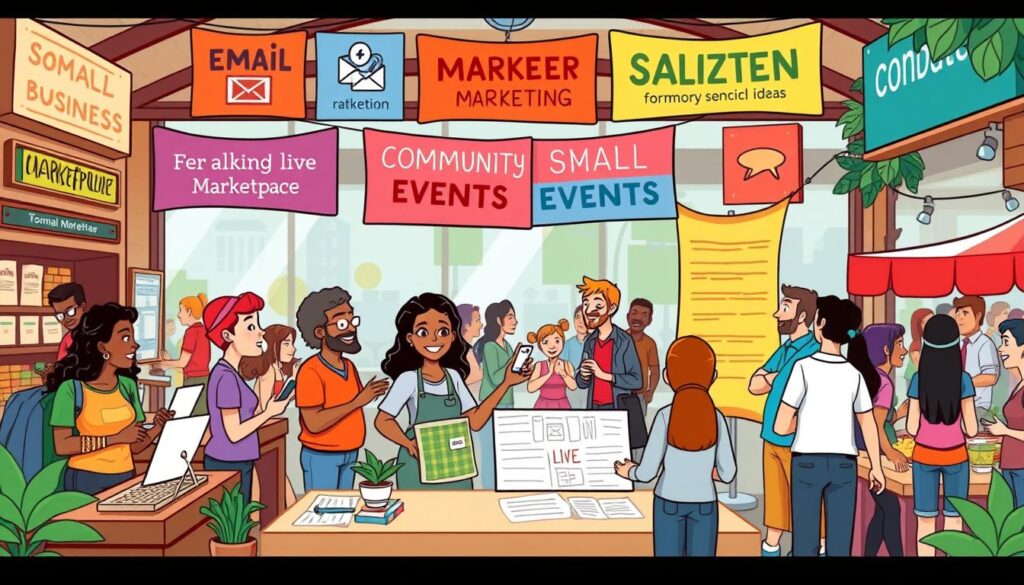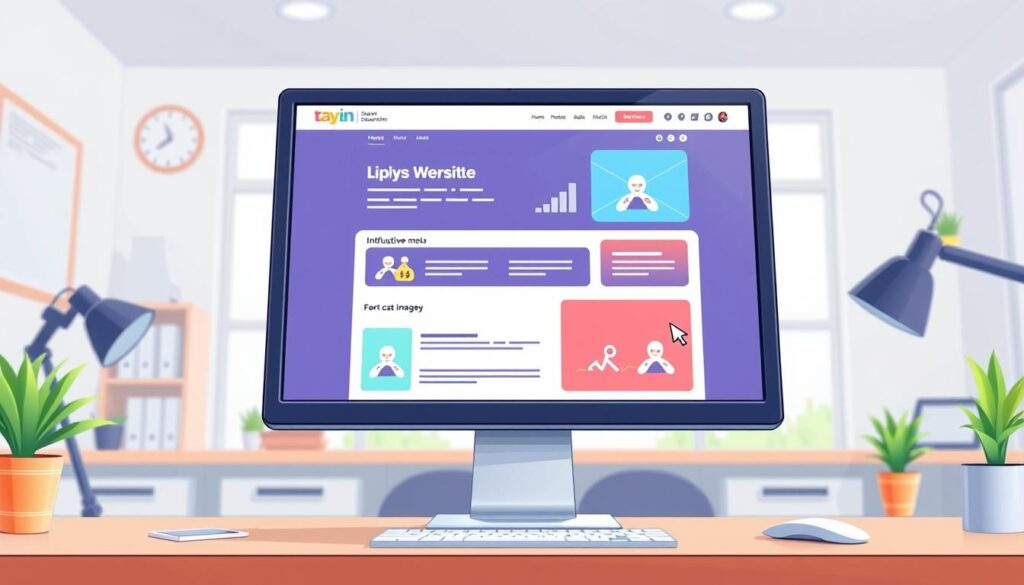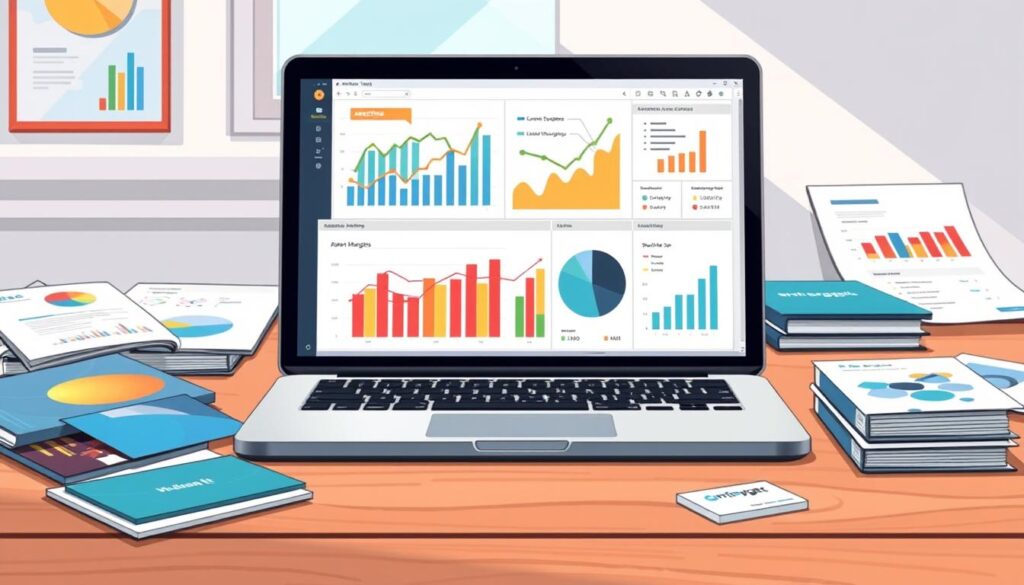The number of global e-commerce customers is set to jump to two and a half billion by 2028. This big jump shows how important it is for small businesses to market well. A good marketing plan can bring in new customers and keep the ones you have happy, leading to loyalty.
In today’s world, using digital marketing is key for small businesses to grow. They can use social media and local SEO to reach more people. Revenue Boomers, known as the top SEO agency, helps small businesses get noticed online and sell more.
This guide will show you how to use marketing better. You’ll learn about tools and resources that can really help your business.
Key Takeaways
- Understanding the importance of marketing is essential for small business growth.
- Digital marketing strategies can help small businesses stand out in a crowded market.
- Utilizing social media platforms effectively can connect businesses with their target audience.
- Video content is a powerful tool for increasing engagement and driving sales.
- Local SEO can significantly improve the visibility of small businesses.
- Building customer relationships is a key driver of loyalty and repeat business.
- Adapting to market trends can keep your business relevant and competitive.
Understanding the Importance of Marketing for Small Businesses
Marketing is key for small businesses to sell more and keep customers coming back. It helps make the brand known and boosts profits. Every small business needs a good marketing plan to share its value.
Why Every Small Business Needs a Marketing Strategy
A strong marketing plan matches up with a business’s goals. It makes sure money is spent wisely. Small businesses often face ups and downs in sales, which can mess with their money. Good marketing helps keep customers coming back and brings in new ones.
The Impact of Digital Marketing on Growth
Digital marketing has changed how small businesses talk to customers. With content, social media, and SEO, they can reach the right people. This way, they can connect with customers in real time, building loyalty.
Common Marketing Myths Debunked
Some think marketing is only for big businesses or when money is plenty. But, marketing is essential for growth and keeping customers. It helps a business stand out and be known in the market. For more on marketing, check out this resource.
Identifying Your Target Audience Effectively
Knowing your target audience is key for small businesses to succeed. You need to create detailed customer personas, do deep market research, and study customer behavior. These steps help you connect with potential clients, boosting engagement and sales.
Creating Customer Personas
Customer personas are like profiles of your ideal customers. They include demographics, interests, and more. By making these personas, you understand what drives your customers’ choices. This helps you focus your marketing efforts.
Marketing tailored to your personas can really improve how you connect with your audience.
Conducting Market Research
Good market research is the foundation of a solid marketing plan. It uncovers trends, competitors, and what customers need. By studying customer feedback and competitors, you can target better.
Research shows who spends more, who cares about the environment, and who values deals. With this info, small businesses can tailor their marketing to meet customer needs.
Analyzing Customer Behavior
Studying how customers behave gives you valuable insights. Look at feedback, reviews, and online interactions. This helps you build personal connections and messages.
Keeping your customer personas up to date ensures your marketing stays on track. Amazingly, 81% of small businesses that get their target audience right see more clients. And 92% gain more trust from their brand.
| Strategy | Description | % of Small Businesses Benefiting |
|---|---|---|
| Target Audience Definition | Effectively identifying and understanding target customers | 81% |
| Customer Feedback Analysis | Utilizing reviews and comments to tailor marketing strategies |
86% |
| Market Research Implementation | Investigating industry trends for better targeting | 67% |
| Referral Generation | Acquiring new clients through existing customer referrals |
63% |
Cost-Effective Marketing Strategies to Consider
For small businesses with tight budgets, finding affordable marketing strategies is key. These methods boost visibility and build strong customer connections. We’ll look at three main tactics: social media, email marketing, and local SEO.
Social Media Marketing for Beginners
Social media marketing is a powerful tool for small businesses. It’s cheap to start and can reach many people. Using sites like Facebook, Instagram, and Twitter helps businesses talk directly to their audience.
This approach builds loyalty and engagement. Adding hashtags and sharing useful content makes social media even more effective. Small businesses can also use local groups and events to grow their brand without spending a lot.
Email Marketing: A Small Business Essential
Email marketing is a must-have for effective marketing. Getting email addresses lets businesses talk directly to customers. Personalized emails can really grab attention and keep customers coming back.
Regular emails help build strong customer relationships. Small businesses can target their emails to specific groups, which boosts results. Studies show that email marketing can be very profitable for businesses.
Local SEO Strategies to Boost Visibility
Local SEO is crucial for getting noticed in your area. Setting up a Google My Business listing can bring in more customers. It’s about making sure your business shows up in local searches.
Using local keywords, getting online reviews, and joining local events can help. For better local online presence, learning about SEO practices is important. It helps small businesses stand out in their markets.

| Strategy | Key Benefits | Implementation Tips |
|---|---|---|
| Social Media Marketing | Enhances brand engagement, low-cost outreach | Use relevant hashtags, create community involvement |
| Email Marketing | Direct communication, personalized outreach | Segment audience, focus on engaging content |
| Local SEO | Increased foot traffic, improved search visibility | Optimize Google My Business, gather online reviews |
Building Your Brand Story and Identity
Creating a memorable brand identity is key for small businesses to succeed. A strong brand story combines a company’s mission, values, and personality into one story. This identity helps businesses connect with their audience and boosts their presence.
The Power of Branding for Small Businesses
Branding is crucial for small businesses. About 88% of consumers value authenticity in brands. A consistent brand identity helps a company stand out, especially in a crowded market. It includes names, taglines, designs, and voice, making the brand story compelling.
Crafting a Compelling Brand Narrative
Creating a strong brand narrative means knowing your customers and competitors well. By developing a brand voice and engaging in word association, businesses can share what makes them unique. A memorable business name and social media handles can also help with recognition.
Good branding can increase revenue by about 23%. Brands like Coca-Cola and Burt’s Bees show how a clear identity builds loyalty. For example, POP Fit promotes inclusivity, making it a part of their mission.
In today’s digital world, social media is a cheap way to share your brand’s story. Sites like Instagram and TikTok are great for engaging with more people. Strong branding builds trust and loyalty, helping a business stand out and connect with customers.
Branding that focuses on authenticity and unique values can create deep connections with people. It’s vital for small businesses to understand the importance of branding to succeed. For more tips on building your brand, check out this resource.
Leveraging Social Media for Engagement
Social media has changed how small businesses talk to their audience. Picking the right platforms can really boost your social media game. Each platform has its own special features that help you reach more people.
Choosing the Right Platforms for Your Business
Knowing where your audience hangs out is key. Here’s a quick rundown of popular platforms:
| Platform | Ideal For | Demographics |
|---|---|---|
| Broad audience reach | Diverse demographics | |
| Visually appealing products | Younger demographics | |
| Tech and media engagement | Varied, more urban users | |
| B2B and professional networking | Professionals and businesses | |
| Visual products and DIY ideas | Mainly female audience |
Tips for Creating Engaging Content
Creating great content is key to keeping your audience interested. Here are some tips to boost engagement:
- Use high-quality visuals and videos to catch their eye.
- Ask questions and run polls to get people talking.
- Show your brand’s human side with behind-the-scenes peeks.
- Work with influencers to add credibility and reach.
- Use targeted ads to match what your customers are interested in.
Measuring Social Media Success
It’s important to know if your social media efforts are paying off. Use tools like Google Analytics to track important metrics. This helps you see what’s working and what’s not, so you can make your content better.

Creating a User-Friendly Website
A user-friendly website is key for small businesses to succeed online. With 71% of businesses having a website, it’s clear that a good online presence is vital. A website with the right features can make users happy and help your business grow.
Key Features Every Small Business Website Needs
Here are the must-haves for a user-friendly website:
- Clear navigation to help users find what they need.
- Fast loading times, as 40% of visitors will leave if it takes more than three seconds.
- Content that speaks to your audience.
- Responsive design for easy viewing on all devices.
To make a user-friendly website, follow these five steps: pick a domain name, register it, and choose your design and hosting. Add engaging content and useful pages, optimize for search engines, and review your site before publishing.
Importance of Mobile Optimization
Mobile optimization is crucial, with 45% of website visits coming from mobiles in North America. Since half of web traffic comes from smartphones, having a responsive design is essential. A well-optimized site keeps users happy and helps your business grow, as 61% of people will leave if they can’t find what they need quickly.

Best Practices for SEO Optimization
SEO best practices are vital for better search rankings and more organic traffic. Here are some key strategies:
- Use relevant keywords in your content.
- Post valuable content regularly.
- Make sure your site loads fast for a better user experience.
- Ensure your site works well on mobile devices.
Investing in SEO can boost your visibility and credibility. Regularly check your site’s performance, update content, and consider linking with other reputable sites. Knowing the cost of SEO services helps you budget effectively for a strong online presence.
Networking and Community Engagement
Small businesses grow through connections and relationships. Networking events are key to building these ties. They help businesses become more visible and interact with local communities. This leads to new marketing chances and boosts brand awareness.
Benefits of Local Networking Events
Local networking events are vital for small businesses. They offer:
- Opportunities to form strong bonds with potential customers and partners.
- Chances to find new marketing strategies through direct talks.
- Support from fellow business owners through mentorship.
Partnering with Other Small Businesses
Small businesses can gain a lot from working together. Partnerships lead to:
- Joint marketing efforts that increase visibility in the community.
- Sharing resources to cut down on costs.
- Expanding reach by tapping into each other’s customer base.
These partnerships strengthen community bonds and improve brand reputation.
Engaging with Local Influencers
Working with local influencers is a smart marketing move. It helps businesses:
- Reach a wider audience through influencers’ followers.
- Create content that truly connects with the community.
- Boost online presence with targeted promotions.
Influencers can share a business’s value, attracting new customers. This approach boosts brand loyalty and expands reach.

Getting involved in community projects can lead to success. For more on SEO’s financial benefits and its role in community engagement, see this resource.
Analyzing Your Marketing Efforts
Looking at your marketing efforts gives you key insights. It shows what works and what doesn’t. With marketing analytics, small businesses can track how well different channels perform. This helps understand how customers interact with marketing.
Tracking Performance with Analytics Tools
Using tools like Google Analytics and SEMrush helps track marketing activities. These tools show trends, track website visits, and measure user engagement. Important metrics like conversion rates and ROI help see if marketing strategies are working.
Key Metrics to Monitor
It’s important to focus on key metrics to improve marketing. Here’s a table with the main KPIs small businesses should watch:
| Metric | Description | Importance |
|---|---|---|
| Website Traffic | Total visits to the website | Shows how well content is doing and its reach |
| Conversion Rates | Percentage of visitors taking desired actions | Tells if marketing is bringing in leads or sales |
| Engagement Metrics | Email open rates, click-through rates | Shows how well campaigns are engaging the audience |
| ROI from Paid Advertising | Revenue generated from ad spend | Helps see if ad campaigns are worth it |
Adjusting Strategies Based on Data
It’s crucial to make decisions based on data. Regularly checking analytics helps improve strategies. By looking at results and tracking key metrics, businesses can make their marketing better. This ensures they use their resources well.

Staying Ahead of Marketing Trends
Marketing for small businesses is always changing. It’s important to keep up with new trends to succeed. Retail, healthcare, and tech are big areas for small businesses to focus on.
Digital marketing is becoming more popular. Business owners should watch for new ways to use video, interactive stuff, and personal experiences.
Emerging Trends in Digital Marketing
Small businesses need to understand how people shop and what they want. With more people shopping on mobiles and caring about the planet, it’s key to adapt. Marketing trends are moving towards being more connected and using new tech.
Using AI and IoT can make marketing better by targeting the right people and keeping them interested.
Adapting to Changes in Consumer Behavior
It’s important for small businesses to change with what people want. By keeping an eye on digital marketing trends, they can guess what’s coming next. This is especially true since 78% of businesses are spending more on digital.
Knowing about voice search and local SEO is also important. These tools change how people find things online.
Continuous Learning and Adaptation Strategies
Small businesses need to keep learning to stay ahead. By checking how they’re doing and what others are doing, they can make smart choices. This helps them stay competitive and grow.






